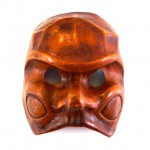COMMEDIA dell’ARTE, or simply “Commedia”, is the foundation of all comedy
Physical, verbal, observational, satirical…

The societal structures and human foibles of 17th and 18th Century Italy provided rich pickings for this, the most vibrant and surprising of all theatre-forms, to originate and grow.
Russell studied Commedia at the École Internationale de Théâtre Jacques Lecoq, in Paris – the peak training environment for this style of theatre.
The genius of the Commedia story lies in the Geo-politics of its characters and their interplay.
Each character originated from, and represents, the characteristics of its own class and region:
The lowest-status servant – the country-bumpkin Arlecchino, comes from Bergamo Basso, (the lower quarters of the town of Bergamo, Reggio Emilia.)
The ageing misanthrope, Pantalone. is the ‘Merchant of Venice” – inhabitant of the thriving city-of-trade which was the hub of 16th and 17th Century Italian Art and Commerce.
Venice was where all the disparate characters turned up, in a transmigration not unlike the movement of peoples today – towards the work, the cultural riches, the vibrancy, the possibility, the EXPERIENCES of the big city.
During the study of this form, Russell had the opportunity to observe random moments of hilarity and brilliance – to encounter the surreality and human magic – this world over which the half-masks preside.
Once back in Australia, he pursued this elusive passion.
In Bali, Russell met the mask-maker Ida Bagus Anom, and commissioned him to carve wooden molds of some Commedia characters – Capitano, Arlechino, Pantalone and Tartaglia, from which he painstakingly made leather masks.
He taught a great deal of Mask-work in a theatre-context… brilliant and unique actor-training, but also developed a training which can unlock surprising resources in the individual, be they actor or not.





